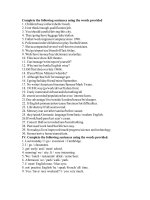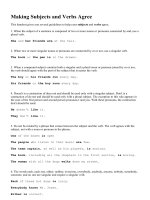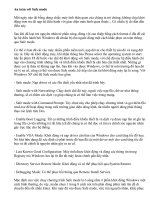Making Liberia Safe potx
Bạn đang xem bản rút gọn của tài liệu. Xem và tải ngay bản đầy đủ của tài liệu tại đây (561.18 KB, 118 trang )
This document and trademark(s) contained herein are protected by law
as indicated in a notice appearing later in this work. This electronic
representation of RAND intellectual property is provided for non-
commercial use only. Permission is required from RAND to reproduce, or
reuse in another form, any of our research documents.
Limited Electronic Distribution Rights
Visit RAND at www.rand.org
Explore RAND National Defense
Research Institute
View document details
For More Information
This PDF document was made available
from www.rand.org as a public service of
the RAND Corporation.
6
Jump down to document
THE ARTS
CHILD POLICY
CIVIL JUSTICE
EDUCATION
ENERGY AND ENVIRONMENT
HEALTH AND HEALTH CARE
INTERNATIONAL AFFAIRS
NATIONAL SECURITY
POPULATION AND AGING
PUBLIC SAFETY
SCIENCE AND TECHNOLOGY
SUBSTANCE ABUSE
TERRORISM AND
HOMELAND SECURITY
TRANSPORTATION AND
INFRASTRUCTURE
WORKFORCE AND WORKPLACE
The RAND Corporation is a nonprofit
research organization providing
objective analysis and effective
solutions that address the challenges
facing the public and private sectors
around the world.
Purchase this document
Browse Books & Publications
Make a charitable contribution
Support RAND
This product is part of the RAND Corporation monograph series.
RAND monographs present major research findings that address the
challenges facing the public and private sectors. All RAND mono-
graphs undergo rigorous peer review to ensure high standards for
research quality and objectivity.
David C. Gompert, Olga Oliker, Brooke Stearns,
Keith Crane, K. Jack Riley
Prepared for the Office of the Secretary of Defense
Approved for public release; distribution unlimited
Making Liberia Safe
Transformation of the
National Security Sector
The RAND Corporation is a nonprofit research organization providing
objective analysis and effective solutions that address the challenges
facing the public and private sectors around the world. RAND’s
publications do not necessarily reflect the opinions of its research clients
and sponsors.
R
®
is a registered trademark.
© Copyright 2007 RAND Corporation
All rights reserved. No part of this book may be reproduced in any
form by any electronic or mechanical means (including photocopying,
recording, or information storage and retrieval) without permission in
writing from RAND.
Published 2007 by the RAND Corporation
1776 Main Street, P.O. Box 2138, Santa Monica, CA 90407-2138
1200 South Hayes Street, Arlington, VA 22202-5050
4570 Fifth Avenue, Suite 600, Pittsburgh, PA 15213-2665
RAND URL: />To order RAND documents or to obtain additional information, contact
Distribution Services: Telephone: (310) 451-7002;
Fax: (310) 451-6915; Email:
Cover Photo Courtesy REUTERS/Tim A Hetherington/Landov
Liberian police stand guard at an evening concert celebrating the inauguration of President
Ellen Johnson-Sirleaf in Monrovia, January 16, 2006. Johnson-Sirleaf took office as Africa's
first elected woman president, pledging to break with the country's history of corruption and
violence that spread war to neighbouring states.
The research described in this report was prepared for the Office of the
Secretary of Defense (OSD). The research was conducted in the RAND
National Defense Research Institute, a federally funded research and
development center sponsored by the OSD, the Joint Staff, the Unified
Combatant Commands, the Department of the Navy, the Marine Corps,
the defense agencies, and the defense Intelligence Community under
Contract W74V8H-06-C-0002.
Library of Congress Cataloging-in-Publication Data is available for this publication.
ISBN 978-0-8330-4008-4
iii
Preface
is report is the final component of the RAND Corporation’s research
project with the U.S. government under which RAND was asked to
advise the Liberian and U.S. governments on security sector transfor-
mation in Liberia. is report should be of interest to the Liberian
government, the U.S. government, the United Nations, other countries
and organizations now engaged in reforming Liberia’s security sector,
and students and practitioners of security sector reform in general.
By agreement with the U.S. and Liberian governments, and by
RAND’s own tradition, the analysis and findings of this report are
independent. Although RAND worked closely with both governments
in performing this study, the results are not to be taken as the views of
either government.
is research was conducted within the International Security
and Defense Policy (ISDP) Center of the RAND National Defense
Research Institute, a federally funded research and development center
sponsored by the Office of the Secretary of Defense, the Joint Staff,
the unified combatant commands, the Department of the Navy, the
Marine Corps, the defense agencies, and the defense Intelligence
Community.
For more information on RAND’s International Security and
Defense Policy Center, contact the director, James Dobbins. He can
be reached by email at ; by phone at 703-
413-1100, extension 5134; or by mail at the R AND Corporation, 1200
South Hayes Street, Arlington, Virginia 22202-5050. More informa-
tion about RAND is available at www.rand.org.
Contents
v
Preface iii
Figures
ix
Tables
xi
Summary
xiii
Acknowledgments
xxv
Abbreviations
xxvii
CHAPTER ONE
Introduction 1
CHAPTER TWO
Security Environment and Demands 5
Background
5
General Environment
8
Internal Security Challenges
9
External Security Challenge
11
Security Concept and Core Functions
13
CHAPTER THREE
Criteria and Principles 17
Criteria for Assessment
17
Principles
22
vi Making Liberia Safe: Transformation of the National Security Sector
CHAPTER FOUR
Forces 25
Building Blocks, Roles, and Missions
25
Capabilities Architecture
26
Force-Structure Options
29
Effectiveness, Costs, and Cost-Effectiveness
31
Internal and External Balance
33
Testing Force Plans Against Potential reats
35
International Forces and Integrated Force Plans
37
CHAPTER FIVE
Organizing Government 41
Current Security Organizations
41
National Security Decisionmaking Body
45
National Military Command Authority
47
Domestic Use of the Army
48
Police and Policing Functions
50
Police Oversight
58
Borders
61
Intelligence
62
Integrated Architecture
64
CHAPTER SIX
Other Issues 67
Legal Framework for Security
67
Policing Priorities
70
Justice and Courts
71
Redundancy
72
Wages
72
International Security Cooperation
73
CHAPTER SEVEN
Key Findings and Implementation Priorities 75
Forces
75
Organizing Government
76
Contents vii
Special Issues 78
Immediate Implementation Priorities
78
Capacity Building
79
APPENDIX
A. West African Military Balance 81
B. Costing
83
Bibliography
85
Figures
ix
S.1. Integrated Architecture and Core Functions xx
2.1. Security Concept and Functions
15
4.1. Capabilities Architecture
29
4.2. Force Size Options
31
4.3. Operating Costs of Options
32
4.4. Capital Costs of Options
33
4.5. Spectrum of Dangers and Capabilities
36
4.6. Integrated Force Plan
38
5.1. Integrated Architecture and Core Functions
65
Tables
xi
S.1. Costs for ree Force-Structure Options xvi
4.1. Force Options
30
4.2. Projected Cost of Maintaining an International Presence
in Liberia
39
5.1. Current Security Organizations
42
5.2. Disposition of Security Organizations
66
A.1. Armed Forces per Capita in West Africa
81
A.2. Armed Forces per Square Mile of Territory in West Africa
82
xiii
Summary
e security institutions, forces, and practices of the regime of Charles
Taylor, Liberia’s former president, met none of the essential criteria for a
sound security sector: coherence, legitimacy, effectiveness, and afford-
ability. ey were meant to serve the regime, not the nation, and were
controlled and used—rather, misused—by one man, mainly against
Liberia’s people and neighbors.
Yet even under new, able, and decent leadership, the old struc-
tures and ways are unworkable, wasteful, and confused, and they enjoy
neither the trust nor the cooperation of the Liberian people at this criti-
cal juncture. It follows that Liberia must make a clean break, adopting
a new security architecture, forces, management structure, and law.
e government of President Ellen Johnson Sirleaf has made secu-
rity sector transformation a high priority, and the United Nations, the
United States, and others are helping Liberia build new forces. What
has been done and planned so far to transform the Liberian security
apparatus is valid and important; this study raises no fundamental
questions about the soundness of what is already under way.
At the same time, Liberia and its partners need an overall secu-
rity architecture, accompanied by a strategy to create it. Without an
architecture and strategy, setting priorities will become increasingly
difficult; gaps, redundancies, confusion, and political squabbling over
forces are likely. In offering an architecture and strategy, this study
identifies additional measures, including additional capabilities, that
would make Liberia’s security sector more coherent, legitimate, effec-
tive, and affordable.
xiv Making Liberia Safe: Transformation of the National Security Sector
e starting point for this inquiry is an analysis of Liberia’s secu-
rity environment, which is complex, fluid, and fraught with risk. Libe-
ria faces a present danger of growing lawlessness and poor public safety,
owing primarily to its large pool of jobless and unschooled youth,
whose only experience is fighting. If public safety and the rule of law
are not established and maintained, odds are all too good that more
severe domestic threats will arise. In particular, political opportunists,
warlords, or criminal figures may lure and organize ex-fighters into
armed groups beyond the reach of, and ultimately endangering, the
state. Because this could happen quickly, capabilities that strengthen
dissuasion and preempt internal threats are at a premium.
e risk of sudden threats from abroad cannot be excluded. Even
if outright state aggression against Liberia is improbable in present con-
ditions, the potential exists for incursions by insurgents operating from
adjacent states and for use of Liberian territory by insurgents to attack
those states.
In this environment, Liberia needs an integrated security concept to
guide the formation and use of new forces and of new institutions to
manage those forces. at concept should entail
concentrating on known challenges of law enforcement and
public safety
dissuading, deterring, and—if need be—defeating any organized
internal threats that may arise
preparing to defend against external aggression by states or, more
likely, by nonstate actors.
From this concept, we derive core security functions:
regular policing
protecting and developing transportation links, infrastructure,
and natural resources
protecting key officials
preventing and responding to civil unrest
preventing and defeating organized armed opposition, up to and
including full-blown insurgency
•
•
•
•
•
•
•
•
Summary xv
providing border and coastal security
responding to outright aggression
developing appropriate and mutually beneficial relationships with
neighbors and other interested parties
collecting intelligence to support these functions.
Liberian security forces, supported by intelligence capabilities,
must be able to fulfill these core functions in a cost-effective manner.
e Liberian National Police (LNP) and Armed Forces of Liberia (AFL)
are Liberia’s basic building blocks for performing these functions.
e primary missions of the LNP are (a) to prevent and fight
crime and (b) to maintain public safety. ese missions call for a light,
but sizable, community-friendly police force that can earn the confi-
dence and cooperation of the Liberian people. Anticipating occasional
civil disorder, the LNP should also have a branch capable of riot con-
trol (e. g., the police support unit).
e primary missions of the AFL are (a) to safeguard the country
against possible external threats and (b) to support internal security
forces in defeating any insurgency or other internal threat for which
Liberia’s internal security forces prove inadequate on their own. At pres-
ent, nonstate external and internal threats are more likely than threats
from neighboring states. e size of the AFL is less important than that
it be superior in quality and capability to foreseeable threats.
In view of Liberia’s particular security demands, this basic force
structure can be enhanced by including in the LNP a small mobile
“swing” police unit capable of (a) helping regular police meet height-
ened internal dangers, (b) challenging armed groups that form in defi-
ance of the state’s authority, and (c) operating with the AFL, if need be,
to meet major internal or external threats. is quick-response police
unit (QRPU) should be oriented toward law enforcement but also
trained and equipped for light combat operations. QRPU personnel
would be drawn mainly from the rest of the LNP; rotation of person-
nel through the LNP, including tours in the QRPU, would facilitate
interoperability.
is overall architecture should provide flexibility, speed, and
geographic reach. e QRPU would permit the regular LNP to be
•
•
•
•
xvi Making Liberia Safe: Transformation of the National Security Sector
lightly armed and community-oriented, and it would reduce the state’s
reliance on AFL intervention to quell domestic threats.
Liberia’s core security functions also indicate a need for a modest
Coast Guard, in addition to the Customs and Immigration services
and the Special Security Service (SSS) to protect national leaders.
In analyzing specific force-structure options (detailed in Chapter
Four of this volume), we found the following (see Table S.1):
Existing plans of the United Nations (UN), the United States,
and Liberia to build a small LNP and small AFL (Option 1),
while sound, may not be adequate to meet Liberia’s needs—espe-
cially for maintaining basic public safety, preventing armed inter-
nal opposition, and providing coastal security.
Doubling the planned size of the LNP and the AFL and adding
a Coast Guard (Option 2), which would result in approximately
$18 million more in annual operating costs, could fall short of
providing adequate security against armed internal opposition
without excessive reliance on domestic intervention by the AFL.
Incorporating a QRPU in the LNP (Option 3) would better meet
Liberia’s security challenges, especially armed internal opposition,
at a $5 million increase in annual operating costs above the cur-
rent plan.
Although the capital cost of Option 3 would be about $24 mil-
lion more than that of Option 1—because of the addition of a
QRPU and Coast Guard—it would cost $43 million less to build
than Option 2. is seems like a wise investment for Liberia and
its supporters, yielding effective security on an economical oper-
ating basis.
Table S.1
Costs for Three Force-Structure
Options ($millions)
Option
Operating
Cost
Capital
Cost
117.894.9
235.4162.1
322.5118.9
•
•
•
•
Summary xvii
e force structure of Option 3 covers the full spectrum of inter-
nal and external dangers, including those from armed gangs and insur-
gency. At the same time, the ability of Liberian security forces to meet
these dangers can be affected by poor road access, aggravated by the
difficulty in moving during the rainy season. is problem can be
reduced by good surveillance, rotary-air mobility (provided by a foreign
partner), preemptive action, and isolation of armed groups in inacces-
sible areas, as well as by the ability to act in force when roads become
passable. Improving Liberia’s roads is important for its security.
e United Nations Mission in Liberia (UNMIL) is critical to
Liberia’s security and will remain so for some years to come. It will
take about five years before the main Liberian forces have been fully
built, equipped, trained, and deployed.
1
During that period it should
be possible to scale back significantly the numbers of UNMIL peace-
keepers and correspondingly reduce UNMIL costs, provided certain
critical UNMIL capabilities are preserved—especially police advisors,
UNMIL’s own quick-response force, and rotary-wing air transport and
surveillance. During this transition, command and control arrange-
ments between UNMIL and Liberian security forces must be delin-
eated and coordinated with great care.
Although it is unclear whether the UN will be prepared to main-
tain any presence beyond the time Liberian forces reach full strength, a
tailored residual presence, on the order of no more than 3,000 person-
nel, could be needed for at least one or two years thereafter, given stable
conditions, to ensure that conflict and chaos do not return. Beyond
that time and for some time to come, a small but critical need will
remain for international (not necessarily UN) capabilities, including
advisors, rotary-wing air transport and surveillance, to complement
Liberian forces. e cost of such a post-UNMIL international capabil-
ity has been estimated in the body of this monograph; it is not included
in the Liberian force-structure options.
Because Liberia’s security environment is dynamic and unpre-
dictable, force plans and the force structure itself must be adaptable.
1
is assumes a benign environment and significant continued and new assistance. e
time frame is therefore somewhat notional.
xviii Making Liberia Safe: Transformation of the National Security Sector
is goes not only for the mix of capabilities of Liberian security
forces—e.g., the size of the regular police, the relative importance of
the QRPU, the size and firepower of the army—but also for the rate
at which UNMIL can be drawn down. is demands tight planning
links between the Liberian government, the U.S. government, and the
UN. Liberia must develop its own ability to plan its needs for forces
and other security capabilities based upon informed, objective, and
realistic analysis. It must neither underestimate the security difficulties
it faces nor overestimate its ability to maintain capabilities. Creating a
civilian and military capability to assess, plan, and align its resources
with its needs should become part of the assistance Liberia receives
from its international partners in the coming years.
As important as Liberia’s forces are its security institutions—the
management structures, responsibilities, authorities, processes, and
rules—that will assure coherent, legitimate, effective, and affordable
direction to, control of, and support for security forces. ese institu-
tions are needed not only for Liberia’s long-term security but also to
guide security sector transformation starting now. e following merit
immediate consideration:
A Liberian National Security Council (NSC) for policymak-
ing, resource allocation, and crisis management should be cre-
ated and used regularly. e NSC would be chaired by the
President and would include as its core the Ministers of Justice,
Defense, Finance, and Foreign Affairs (with others included ad
hoc). It would receive objective analysis and advice from the head
of national intelligence, the most senior officers of the LNP and
AFL, and the Liberian National Security Advisor (LNSA).
is cabinet-level NSC should in turn serve as a template for,
and should insist upon, interministerial information-sharing and
coordination at lower levels—a bureaucratic challenge for any
government, but essential for Liberia. Multilevel interministe-
rial cooperation will take time to effect; all the more reason to
encourage it now.
e LNSA should have several responsibilities: orchestrating the
NSC system at and below the cabinet level; ensuring that the Pres-
•
•
•
Summary xix
ident and NSC receive objective analysis, options, and all points
of view; fostering direct ties among key ministries and agencies;
monitoring the progress of security sector transformation; and
monitoring the quality of operational cooperation among the var-
ious security services. e LNSA should not be involved in regu-
lar ministry affairs or come between ministers and the President.
e chain of command over the AFL—the country’s strongest
force—should be clarified: from the President, as commander-
in-chief, through the Minister of Defense to the senior military
commander, with the understanding that decisions to use mili-
tary force should be reached by the deliberation of the NSC as
a whole. Any military domestic intervention, moreover, would
require consultation with the legislature.
Several ancillary police should be consolidated into the LNP,
with the exception of certain specialized services—Special Secu-
rity Service for executive protection, Immigration and Natural-
ization, Customs, and the Coast Guard.
Other ancillary police agencies should be eliminated and their
personnel vetted for possible service in the LNP.
e LNP should be aligned under the Justice Ministry while
maintaining operational control within the LNP, with an inde-
pendent board to maintain professional standards and public
trust of the police.
Intelligence capabilities are an essential complement of the various
armed services and must be held to the same standards of effectiveness,
affordability, legitimacy, and coherence. Responsibility and capability
to collect intelligence should be concentrated in a National Security
Agency (NSA) that (a) reports to the President; (b) provides analysis
to the entire NSC; (c) furnishes information directly and continuously
to the LNP and AFL; and (d) is authorized to arrest and briefly detain
only persons who pose national security threats. us, the intelligence
service is a support organization for the rest of the security sector. Rec-
ognizing that the police will be able to collect much of the information
needed to investigate and fight crime, the NSA should focus on high-
threat concerns and can be of modest size.
•
•
•
•
xx Making Liberia Safe: Transformation of the National Security Sector
Taking this analysis of force structure and institutions into
account, it is possible to assemble a complete architecture, as shown
below. is architecture would have the following characteristics (see
Figure S.1):
e NSC, chaired by the President as commander-in-chief, has
final authority over all security forces.
Security forces report through ministries rather than directly to
the President.
Security forces are distributed between the Justice and Defense
ministries.
Lines of authority are clear.
Control over the military passes from the President through the
Minister of Defense.
Figure S.1
Integrated Architecture and Core Functions
RAND MG529-S.1
• Concentrate on public
safety, law enforcement
– Executive security
– Border management
– Transport, coastal,
resource protection
– Regular policing
• Dissuade, deter, defeat
organized internal threats
– Control civil unrest
– Prevent armed
opposition
– Defeat major armed
opposition
• Prepare for external
defense
– Defend, control borders
– Respond to aggression
Each function requires force
and intelligence capabilities
NSC
Executive
security
Public
board
Military chain
of command
Direct
intelligence
sharing
MoF
MoJ
President
MoD
MoFA
Other
ministries
AFL
NSA
Customs
SSS
Core security functionsForcesInstitutions
NSC advisors
LNP
AFL
NSA
LNSA
LNP
QRPU
PSU
Coast Guard
BIN
•
•
•
•
•
Summary xxi
e number of distinct security forces and services is manageably
small, while still allowing for specialization.
No security force lacks an important core security function.
No core security function lacks a force that is principally respon-
sible for it, and there is no confusion or duplication in the align-
ment of forces with functions.
e QRPU can support other police units or support the AFL.
e intelligence service (NSA) reports to the President, serves the
NSC as a whole, and provides direct support to the LNP and
AFL.
is architecture should be presented and codified in a way that
secures broad political support, earns public understanding and trust,
and signals the government’s clarity of purpose and resolve, includ-
ing toward potential adversaries. A new omnibus national security law,
though a political challenge to enact, is a better way to meet these
needs than revising each law now on the books or instituting a new
system by presidential decree.
In the course of preparing this integrated approach, we identified
several issues in need of immediate attention:
Security personnel should stay out of politics, except for having
the right to vote.
To avoid discontinuity and political manipulation, senior sub-
cabinet security officials (except for the LNSA) and uniformed
officers should be nominated by the President and confirmed by
the legislature for fixed terms, not changed with a government
transition.
As the new LNP is being built, its patrols need to be accompanied
and mentored by armed international civilian police (CIVPOL)
advisors.
Liberian justice, courts, and corrections systems must be built
quickly or law enforcement will be neither effective nor legiti-
mate; this effort is now woefully under-resourced.
•
•
•
•
•
•
•
•
•
xxii Making Liberia Safe: Transformation of the National Security Sector
Personnel of the former police force and other security forces who
are not to be trained and integrated into the new force should be
retired immediately, lest they infect new police with bad habits.
Current systems for paying security personnel must be upgraded
and made immune to corruption.
Liberia must not and need not be left to face its dangers alone.
Even as Liberian forces gradually take over from UNMIL, and as new
security institutions are built, those with a stake in Liberia’s security—
the UN, the AU, the Economic Community of West African States
(ECOWAS), the United States, other countries, and international
organizations—should continue to help. Liberia should forge coopera-
tive ties with its neighbors in the Mano River Basin, including coor-
dination against common nonstate threats. e UN Security Coun-
cil should make clear through continuing resolutions that its concern
for Liberia will not fade with the gradual reduction of UNMIL. e
United States must be steadfast in its support for Liberia, making it a
model of how a failed state can be made secure and viable. As others
offer to help Liberian security sector development, their efforts should
conform to Liberia’s chosen principles, architecture, and standards.
Implementation should focus on the following:
Immediate and consistent use of the NSC to guide security sector
policy, planning, resource-allocation, and transformation
Development and coordination of detailed integrated (UNMIL-
Liberian) force plans with the United States and the UN
Public education, political consensus-building, and preparation
of a national security law
Stepped-up and regular joint LNP-CIVPOL patrolling to solidify
the rule of law, provide evidence of deterrence, and show that the
state is making progress
Plans to assure uninterrupted continuation of UNMIL’s own
quick-response force
A design and plans for a small LNP QRPU and small Coast
Guard
•
•
•
•
•
•
•
•
Summary xxiii
Consolidation, reduction, and appropriate recruiting, vetting,
and training of the currently independent ancillary police forces,
customs, and intelligence personnel
Attention to building court and corrections-system capacity
Training (e.g., at the U.S. Africa Center for Strategic Studies and
other institutions) of senior officials and officers in the precepts
and practicalities of Liberia’s security sector.
To conclude, the presence of UNMIL, the commitment of the
United States, and a somewhat less hostile external security environ-
ment—albeit one that may change rapidly—provide Liberia with valu-
able time to create security institutions and forces that are effective
against dangers, are legitimate in the eyes of Liberia’s people and neigh-
bors, fit together and work coherently, and are worth the cost. is
study is meant to help Liberia and its supporters use that time well.
•
•
•









